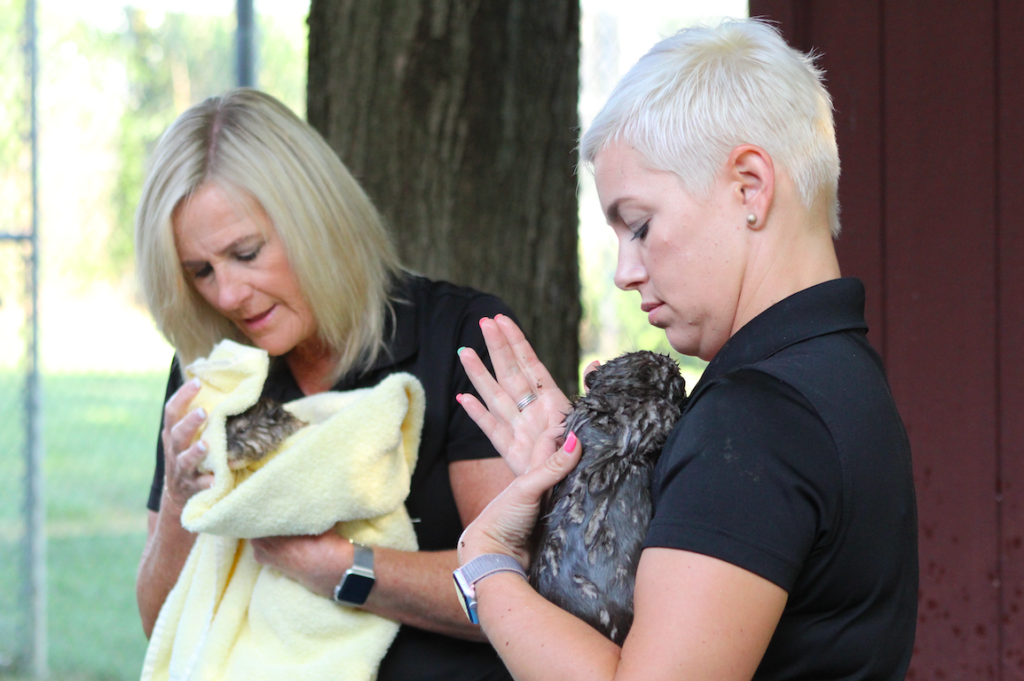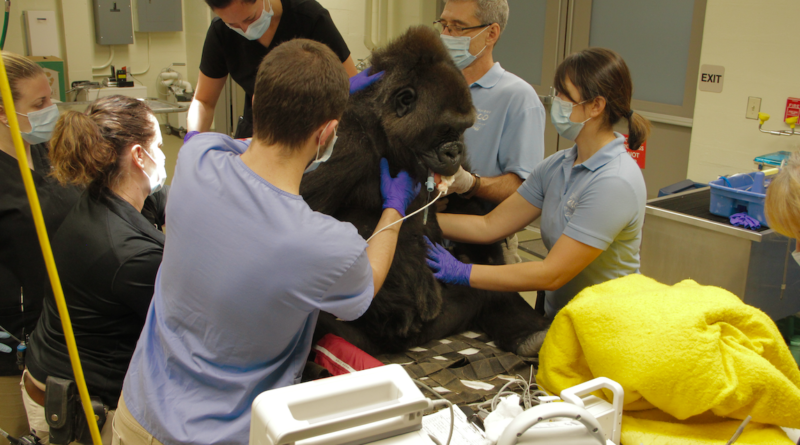INTERVIEW: Nat Geo Wild shares more ‘Secrets of the Zoo’
Photo: Vet staff work on Oliver the gorilla at the Columbus Zoo and Aquarium. Photo courtesy of National Geographic / Jesse Kennedy / Provided by press site with permission.
The Columbus Zoo and Aquarium, along with its sister property The Wilds, boasts 2,000 employees and 10,000 animals, meaning it’s an awfully large operation, and the ins and outs of that operation are the subject of the Nat Geo Wild reality series Secrets of the Zoo. New episodes from season three air Sundays at 9 p.m. on the network.
The series tells the many stories that can be found in the expansive facility: from the veterinarians who take care of the animals to the actual animals themselves. There are adventures and narratives involving everything from beavers to ducks to cheetahs to cougars to gorillas and even a sloth bear.
Tom Stalf is the CEO of the Columbus Zoo and Aquarium, and he seems quite excited to open the facility once again to members of the public. Due to the coronavirus pandemic, the zoo is currently closed until further notice. “The zoo closed in mid-March,” Stalf said, “and we’ll open up when the time is right.”
When the zoo’s administration was approached about the possibility of having cameras document their staff’s every move, they were an immediate yes. They wanted Secrets of the Zoo to serve as a platform to promote their efforts in conservation and animal welfare.
“We’re always very proud to show off our staff and their passion for what they do every single day,” the CEO said. “It’s very important for us to share the details and the behind-the-scenes, so when we were approached to talk about the opportunity to highlight our team and our animals, it was easy for us to say yes. … Our great friend, Jack Hanna, has been with the Columbus Zoo for over 40 years, and he has three shows currently that are syndicated. So we were used to having cameras here and highlighting the greatness that we do, so, yeah, we wanted to continue that.”
The series has been a hit for the network, which is no doubt why they renewed the show for a second season. Now many of the human characters on the series have become stars in their own right — not to take away from the bonafide rockstar status of the animals themselves.
“We hear that quite often,” Stalf said of his staff being recognized in the public. “We’re very proud. Here at the Columbus Zoo and Aquarium and The Wilds, we see, well, literally millions of people a year, so nearly 3 million guests comes to our facilities. And we are very proud to welcome all of our guests in. There’s really no way to measure if they’re coming because they see the show, but I know that the thing that I love about Secrets of the Zoo focusing on The Wilds and Columbus Zoo, it’s highlighting so many stories. But I will tell you there are so many stories out there that we’re not highlighting. I’ll give you an example. We have 114 different conservation projects in 46 countries. We’re part of an organization that contributes $231 million every year for field conservation. When we sit back and we talk about why zoos matter, for me, there’s many ways to measure our success. You can measure it by your attendance. You can measure it by how many animals you have and the staff and all the greatness that we do, but for me, it’s what we can contribute worldwide for global conservation. And that’s a great story that we haven’t highlighted yet.”
Suzi Rapp is the vice president of animal programming at the Columbus Zoo. She is a frequent presence on the series, and she hopes the show can effectively highlight the staff’s dedicated efforts, especially for those viewers who may be skeptical of zoo facilities.
“I think that this show has done a really good job of doing that,” Rapp said. “Zoos, in general, I think we were a little bit late coming to the forefront and telling our story, and I think it’s just that we are caught up in doing conservation work and obviously good animal welfare and taking care of our collections that we really weren’t getting that message out there. I think that’s the beauty of these shows is we have opened our doors. … Nothing is sacred. Anybody can see what we’re doing, and I think what people are finding out is it’s nothing but a labor of love, hard work, and obviously the animals come first. This has been a great avenue for us to be able to share that message.”

Stalf and Rapp recognized that there is a criticism that exists against zoo facilities, but they stay focused on their mission statement: lead and inspire by connecting people and wildlife.
“If we can touch the lives on a Sunday evening while you’re with your family … I think that’s what it’s all about,” Stalf said. “We do that everyday, and if we can do it with Nat Geo as a partner, that’s definitely an added bonus.”
No doubt one of the highlights of working at the Columbus Zoo and Aquarium is the chance to work intimately with the many animal species on exhibit. For Rapp, there’s added pleasure in not only caring for the animals but also caring about the humans who come in contact with them.
“We’re both very people-oriented as well, so the wonderful opportunities that we get to do is not only do we get to have those animals, which are so important, but we get to share that with the people,” she said. “I think I’m seeing through the show that staff seem to be enjoying that as well.”
Stalf added: “We have a lot of rockstars here at the Columbus Zoo and The Wilds, and now you’re seeing them. And it’s great that we’re not just focusing on an individual. When I look at some of the other shows, they might have just a few people that are being highlighted, but literally we have 2,500 employees here at the Columbus Zoo and Aquarium. … The great news is this series could go on for years because there’s so many more stories to tell.”
When the zoo finally opens again after the coronavirus pandemic, Stalf and Rapp are excited for guests to see the new additions to the facility. Stalf, for example, pointed out that the zoo has a young polar bear cub who is learning to swim next to mama bear. Conversely, Rapp is anxious for more people to hear of the zoo’s groundbreaking work with cheetahs. Here’s how she summarized it:
“Obviously cheetahs are probably why I do what I do,” Rapp said. “After working at the Columbus Zoo now for four years, cheetahs are definitely my passion. That’s kind of what I’m known for. We partnered with the Smithsonian … and another institution called Fossil Rim in Texas. We’re always working on cheetah reproduction because it’s very complicated, and we haven’t been real successful in artificial insemination. So working with the Smithsonian and their biologists, their scientists, we really decided to work on in-vitro fertilization, and they were asking if the Columbus Zoo would participate. I said, absolutely, because we do have such a large collection of very well-trained cheetahs.”
The Columbus Zoo staff members were able to collect eggs from a genetically valuable cheetah at their facility. The donor was a cheetah named Kibibi, who is going on 7 years old.
“She’s never reproduced cubs,” Rapp said. “We’ve never bred her, so for her to breed at 7 years old is not very likely. And then the Smithsonian has some frozen semen from a good genetic match for Kibibi out of Fossil Rim, a male out of Fossil Rim that has also never bred, so this was a very valuable gene pool to put together. So the scientist from the Smithsonian fertilized the eggs here at the Columbus Zoo, and we put them in one of our other cheetahs named Izzy, a young 3-year-old that is not genetically valuable. We didn’t really want to reproduce her genes; however, she’s an incredible ambassador, a well-trained cat, one of our runners. And she was the first to successfully carry two in-vitro fertilized transferred embryos.”
For Rapp, this successful match, resulting in a pregnancy and birth of two cheetah cubs, is a highlight of her career and no doubt will be a subject on a future episode of Secrets of the Zoo. The reason for her enthusiasm is because this matchmaking tale symbolizes the work that’s being done at the Columbus Zoo and Aquarium.
“You’re looking at less than 7,500 cheetahs left in the wild, with a 95 percent infant mortality rate, so 95 percent of all cheetah cubs born in 2020 will not reach 1 year of age,” she said. “One of the biggest problems with cheetahs is they are so fragmented that their genetic paths are not crossing, so they’re kind of breeding with brothers and sisters and mothers and fathers. So they really need some genetic diversity, and with this science, we could create that genetic diversity. It’s truly something the Columbus Zoo is proud of.”
By John Soltes / Publisher / John@HollywoodSoapbox.com
Secrets of the Zoo airs new episodes Sundays at 9 p.m. on Nat Geo Wild. Click here for more information.

